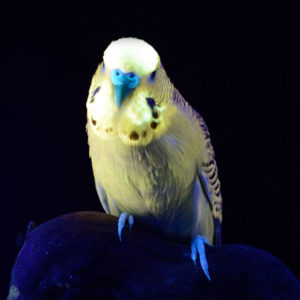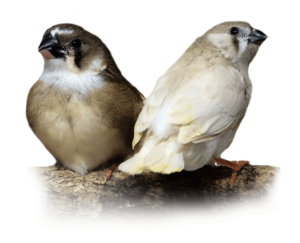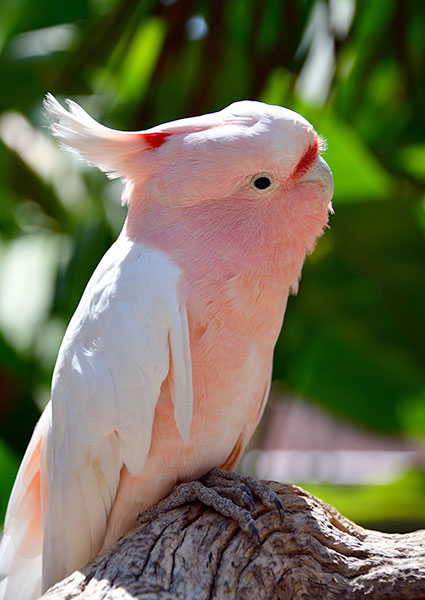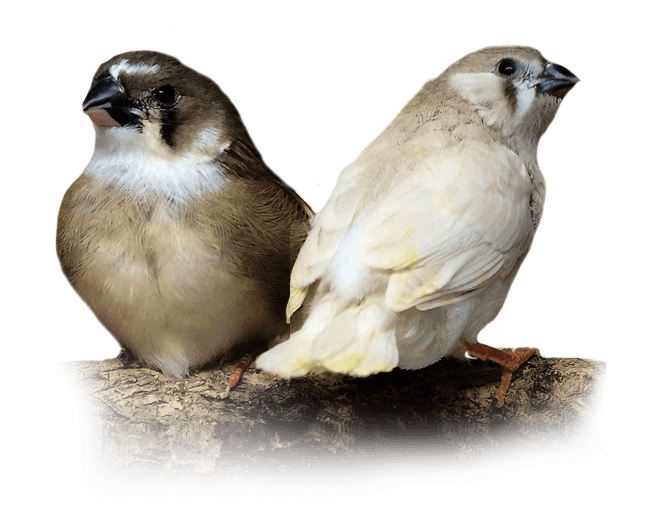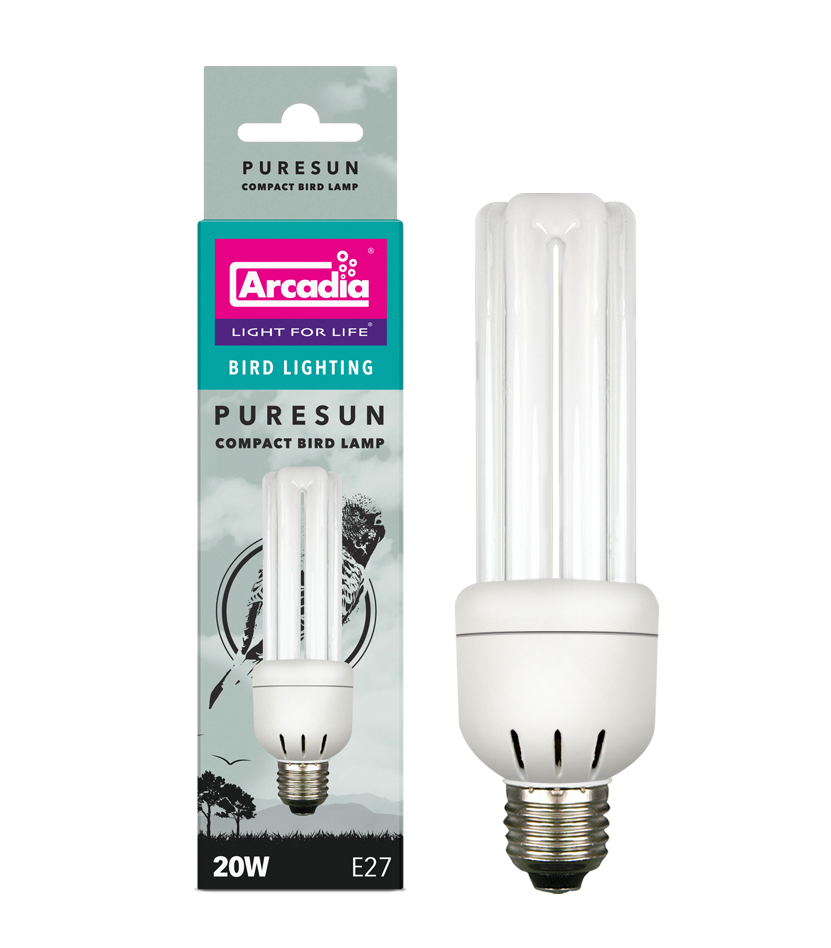
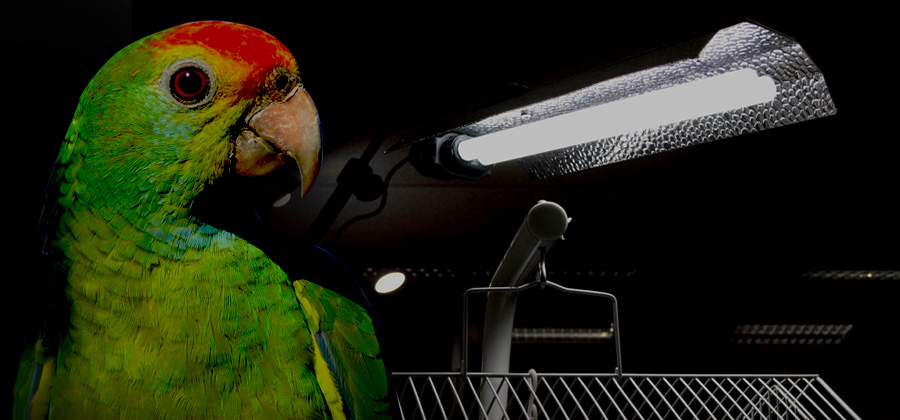
Part 3
What is light and why it so important?
Part 3 / Issue 266
Parrot Magazine / March 2020
What is light and why it so important?
In this third part of John Courteney-Smith’s series on light, he considers how natural light is vital in maintaining the core balance of vitamin D and calcium.
Over the past two features in this series, we have looked at some of the basic elements surrounding the provision of full-spectrum + UV-B lighting, and indeed the very valuable energy contained within this form of lighting for birds. The energy of the sun is the core provider of the earth and without the balance and quantity of its energy pouring down into our world, life could not exist.
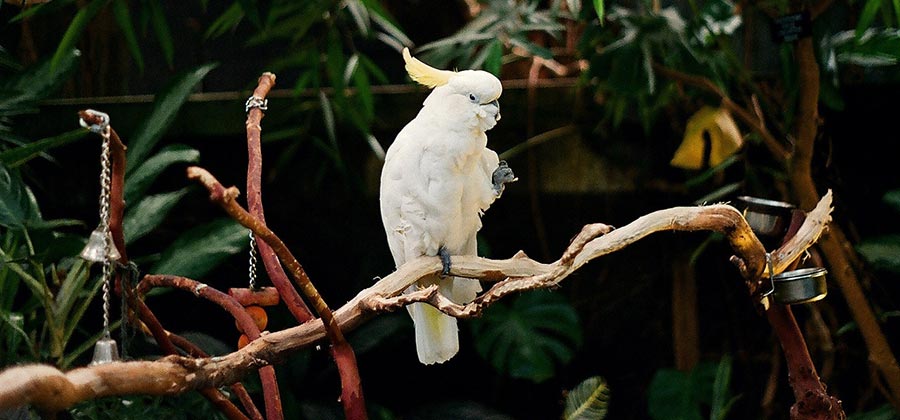
It is this energy that allows the planet to warm, allows photosynthesis which in turn provides the oxygen that is required for respiration, but it also provides food, creates the weather and sets the earth’s magnetic fields. Yes, it is the full-spectrum of the energy that the sun provides us with, after the filtering of our atmosphere, which sustains all life, and that all life has developed to utilise.
If we can accept the theory of constant development over time, also known as ‘natural selection’, we must therefore accept that all of the parameters of supply in which every species has developed, have therefore become the very base of provision, used adroitly for the ongoing needs of each species. All life requires energy from multiple sources, for endothermic species such as birds and humans, we glean energy from food and from the sun as it warms and interacts with us. The sun’s energy also starts and maintains core and vital processes within the dermis, which leads to the creation of essential vitamin D3, in popular terms, the ‘sunshine vitamin’.
Vitamin D is essential to life and without adequate levels being maintained within the body, indeed being freely available in the blood, the body cannot function properly.
Vitamin D has a use and an impact in every cycle and process in the body in some way. Why? Because it is responsible for the maintenance of certain cycles, processes and functions in its own right, but it is also required for the assimilation, storage and use of the earth’s minerals. Without optimum and balanced mineral provision, we have biological imbalance and disease. Life is a series of cycles, all working together and being reliant on each other.
Even cycles, which are not entirely reliant on preformed D3, will require minerals, or the input of secondary cycles that have a mineral or pre-D3 basis. We cannot override this. Imbalance in the diet, over the three parameters of overall-nutrition will always equate to imbalances in the body. Vitamin D, or rather vitamin D3, is commonly known for its ability to allow the assimilation, storage and use of essential calcium. We even see this printed on our own now usually fortified foods and vitamin complexes. Yes, D3 is quite famous and so it should be. Without adequate access to calcium, bones cannot be replenished properly, the blood chemistry goes haywire over time, as does the nervous system. Subsequently, the under supply of minerals, caused either by a lack of minerals in the diet, or an under supply of D3, is a subject that is far more complex than the commonly known diseases attributed to hypocalcaemia such as metabolic bone disorder, commonly referred to as ‘MBD’.
As I have stated in this series already, life is a vast series of cycles and intricate processes, all working with and being reliant upon each other. Each one of these cycles and processes function in total synergy with every other cycle and process in the body being reliant upon receiving the correct type and quantity of energy and the various building blocks of life, be they mineral, chemical, hormonal or bacterial. If we remove one of the ‘suppliers’ of these processes and cycles, we inhibit the ongoing cycles by the same degree of poor supply or imbalance.
It is therefore the ‘whole’ spectrum of the earth’s minerals, provided by food, water and also either purposeful or incidental geophagy in the earth’s natural balance, and then the body’s ability to use these minerals that becomes most important. For this to occur in balance, usable D3 is required. Yes, calcium is essential to life! But it can only ever be as important as the rest of the earth’s minerals in balance. Indeed, calcium and its assimilation, storage and use is very dependent on not only D3, but also the presence of the rest of the minerals.
Calcium also plays an important role in blood chemistry, digestion, organ function, muscle contraction, nerve and brain health and reproduction.
Minerals matter
The minerals that are found in the earth are available to birds via the foods they consume, the water they drink and of course, as particulates that enter the mouth as they find and consume foods (incidental geophagy). Indeed, as parrot keepers, we are all well aware of the clays that many species willingly consume daily, yes these clays work to bind plant toxins, but they are also laden with very usable minerals from the whole natural spectrum. Again, the earth itself is a supplier, and the life that exists on earth will make full use of its bounty!
Minerals work as suppliers, building blocks and facilitators to the body. Minerals such as calcium are not only vital within skeletal health and bone density, but calcium also plays an important role in blood chemistry, digestion, organ function, muscle contraction, nerve and brain health and reproduction.
Here is a vital point for breeders, calcium has as much value to effective copulation and insemination as it is to the creation of strong healthy eggs. Cock birds need strong legs to tread the hen and to create and deliver healthy sperm, but hens also need to produce strong eggs, pass on nutrients to young and also do all of this without detriment to her own health. A lack of calcium, being freely available in the blood can lead to total disaster over time, and not just for bone health. Once again, we can see how important D3 is here.
Calcium is used to maintain life, therefore the body will do all that it can to maintain the correct levels in the blood. If calcium levels fall in the blood, the organs cannot function properly and muscle contraction is affected. As such, it is better to have soft bones for a short time, than it is to allow the heart to lose the ability to contract. The pay-off will be the preservation of life in the perceived short term, but to the detriment of the health of the bone. This is good self-preservation in times of lack in the wild, as there is a fairly good chance the seasons will change soon enough, the sun will re-emerge to full strength and that the reserves can be replenished with no long-term harm done.
Calcium must be available for use via the blood, this is where the D3 cycle and a partnership with Magnesium comes in. Vitamin D3 is needed in the correct quantity in order to allow the assimilation, storage and use of calcium. Without the correct volume of D3, minerals such as calcium almost entirely pass through the body unused, almost regardless of the amount of calcium fed to the animal. Calcium must also be stored in the bones before being required of by the blood. It is this way that calcium is bioavailable and most useful in the body.
Magnesium
It is also worth picking Magnesium out as another star of the show here. Magnesium is another essential earth mineral, usually made available to animals through the ingestion of soil particulates, vertebrates and plants. Magnesium is vital in its own right, working within brain, nerve, digestive and reproductive health, but, it is also vital to the calcium cycles. Magnesium works as a sentinel, instructing calcium, and other minerals to be stored deep in the bones first, rather than getting lost into the soft tissues of the body where they are of no real use. From the bones, calcium becomes viable and can be requested by the blood within its usual uses and cycles. Therefore, D3 is required within constant manufacture as is the ingestion of calcium. It is in this way that the bones are kept fit and strong and the blood potent. Magnesium in the diet is however chronically reduced post war, as commercial fertilisers are reported to inhibit a plant’s ability to store the mineral. Supplementing with calcium/magnesium powders alongside full-spectrum minerals has now become the norm in pet care.
D2, D3
There are two forms of vitamin D. The first is vitamin D2 (ergocalciferol). Vitamin D2 is found mostly in plants. However, D2 is not very effective at all in allowing a high, natural level of assimilation, storage and use of minerals such as calcium. We can take our lead here from obligate herbivores, as having no access to preformed D in the diet, they would be almost totally solar reliant for their D3 to calcium cycle needs. Even vitamin complexes for vegans are made from UV treated mushrooms and some algae’s, again, the result would be D2, and as such be of a lower value to the cycles.
We then have D3 (cholecalciferol). This is the form of vitamin D that is produced after exposure to natural daylight in the skin. It is also available from whole animal foods such as fish, eggs and organs such as liver. D3 is potent and active and is by far the most effective for allowing the correct functions of the calcium/mineral cycles. It is regular exposure to unfiltered terrestrial daylight that is of most value. D3 is the form that life has developed towards and is therefore the one that must be concentrated on when thinking of welfare.
D3 cycle
The term the D3 Cycle is used to describe the many cycles and processes that work together to allow animals, including humans, to produce and utilise preformed vitamin D3 in the skin after exposure to the full-spectrum of unfiltered terrestrial daylight. This is a natural process that is self-regulated and self-limiting, and is able to be recycled within exposure to the sun, or a balanced replicant source.
We then have D3 (cholecalciferol). This is the form of vitamin D that is produced after exposure to natural daylight in the skin. It is also available from whole animal foods such as fish, eggs and organs such as liver. D3 is potent and active and is by far the most effective for allowing the correct functions of the calcium/mineral cycles. It is regular exposure to unfiltered terrestrial daylight that is of most value. D3 is the form that life has developed towards and is therefore the one that must be concentrated on when thinking of welfare.
It is exposure to UV-B predominately that starts the process of vitamin D3 production, but it is the balance of terrestrial UV, which being UV-A and UV-B, that ensures the process is self-regulated and self-limiting.
Unlike D3 provision as a preformed source given orally, D3 provided by balanced UV systems cannot be easily over supplied (we will look at lamp safety and burn risk in part 4). The body will make enough D3 to satisfy the level of need at any given point, and then limit and even recycle portions of the production cycles in order to ensure good availability soon after. The natural UV to D3 cycle is therefore natural, safe, effective and beneficial when provided in balance and to a level of energy that is required by the species.
As this is a core cycle of provision, every stage in the cycle, as per the image must be provided well and within the bounds of wild-like provision. Sleeping, waking, exposure to sunlight, warmth, feeding and movement are all vital to the cycle. In order for a bird to be able to produce the correct volume of D3, it must therefore be exposed to the correct quantity of UV. The easiest way to be sure of this is to use the international unit of measure of UV-Index. By using UVI, we can look at the wild habitats, the local weather and the behaviour of the species and then make an educated choice of how much energy to provide.
Typically, we provide a UVI of between 1.00 and 3.00 for most cage dwelling species. This is a low and safe level that is replicating early to mid-morning sunlight. Subsequently, as birds are exposed in the cage to this quantity of energy, and without a forest to rest in, this lower than the wild level allows them to create enough D3 as they are exposed over time. For birds kept in huge flights, which are well planted and with natural type places to hide, a natural, slightly higher UVI could be supplied over a central ‘basking’ area from which the birds could choose to fly and self-regulate their level of exposure.
With access to the right vitamins and minerals, birds will not only feel better in themselves, but they will be able to assimilate calcium just as they would in the wild. This will help to ensure good bone density, feather/beak/nail production and egg viability. There is also a feeling that a critical lack of D3 can cause birds to become miserable, just as with humans. This can lead to unnatural plucking and bad behaviour. Fortunately, for many as soon as Full-Spectrum+UV-B lighting is provided accurately, the subject frequently seems to start to recover quite quickly.
Exposure to the right levels of UV will also increase useful preening and stimulation of the preening gland (uropygial gland). There is another useful interaction here as the main preening gland is affected in a positive way by exposure to UVB and can itself produce preformed D3, this is then in part ingested while preening. Birds can assimilate terrestrial UV through their feet, cere and any other bare patches of skin. As such, they are actively basking and seeking out exposure when preening in open sunlight.
Water
We must also never forget the vital importance of water! It really is the glue of life. Birds not only require enough water, but that this hydration is provided in a way that a species can use naturally. Water sources should also be of a suitable quality in terms of mineral content and being free from toxins and negative bacterial load. This is as important as using a high-quality food and providing the correct energy from light. Water allows the cycles and processes of the body to occur, its flushes toxins away and can be a welcome provider of full-spectrum minerals, a ‘top-up’ if you will. We can provide perfect lighting and a perfect diet, but without good hydration every cycle will be inhibited in some way. Having access to water correctly, is therefore vital within the D3 cycles and the assimilation, storage and use of minerals such as calcium.
Feather Removal
Feather plucking in birds is a very complex issue and there are many schools of thought of why some birds do this and how to remedy the situation. I am convinced that feather removal, certainly in the early stages is usually always a developed action used by birds to expose skin in order to receive more daylight and rebalance the blood. We should assume a mineral/D3 shortage first. This makes good developmental sense.
If a bird perceives a lack of usable D3 and of course minerals such as calcium, it will need to obtain the groups in some way. The natural way is of course to feed and to expose the skin to daylight. Increasing the quantity of UV getting into the skin will increase the natural and self-regulated production of D3 and therefore also increase the availability of usable calcium. If a bird has a serious lack, I believe they will start to remove feathers in order to create a larger surface area of skin, which can then receive energy from daylight. In the short term the bird would rebalance and stop plucking. However, in captivity, and where birds are maintained indoors with no access to sunlight, the situation becomes ever more serious. The bird will remove more and more feathers and the health of the bird will continue to deteriorate. We know that a serious lack of D3 and calcium has a negative impact on the brain and ‘mental health’, as such, plucking can become habitual even if the bloods are in some way stabilised through medication.
The good news is, that most birds, which I have helped in treatment, have totally recovered and stopped plucking. I have seen some serious cases over the years, but I have also seen some almost miraculous recoveries when birds have been given access to UV and had the wise provision of full-spectrum minerals alongside the help of a suitable vet and accurate ongoing testing.
UV and skin health
Being exposed to natural daylight or a replicant source, such as a full-spectrum+UVB bird lamp, also has a positive direct impact on feather health. UV can also help to increase feather health directly, but also by increasing the quality of preening oils. Feather and skin dwelling bacterial load can decrease, and parasite numbers decrease. As I have already mentioned, the preening gland is positively impacted by terrestrial UV, increasing its quality and after exposure to UV, providing a source of ingestible D3 via the preening oil.

Specialist bird lamps
As we saw in part 1 of this series, specialist bird lamps should be referred to as being ‘full-spectrum+UV-B’. Any lamp can be loosely thought of as being full-spectrum just by producing a colour of light that is similar to natural daylight. These lamps, especially those that are of an LED nature, have little to no positive impact on the health and wellbeing of a bird, other than allowing circadian rhythm.
If a bird has a serious lack, I believe they will start to remove feathers in order to create a larger surface area of skin, which can then receive energy from daylight.
If we are to see the greatest possible impact on our birds, we must use specialist lamps, designed to mimic the energy of the sun, but that also include UV-A and UV-B. If this is not stated on the lamp, or the lamp box within the usual ‘warning triangle’ for UV lamps, it can be assumed that the lamp is of very little value. To be sure that we are catering for the activation of colour vision and of course the production of usable D3, birds must either have access to a suitable specialist lamp or be maintained with open access to unfiltered sun outside. Beware of lamps marked solely as ‘daylight, full-spectrum, SAD’ and of course ‘LED’.
In the next part of this series we will look at the practicalities of fitting bird lamps, how to get the best out of a lamp and how to fit lighting systems that are safe for both the bird and the keeper.
John Courteney-Smith MRSB



